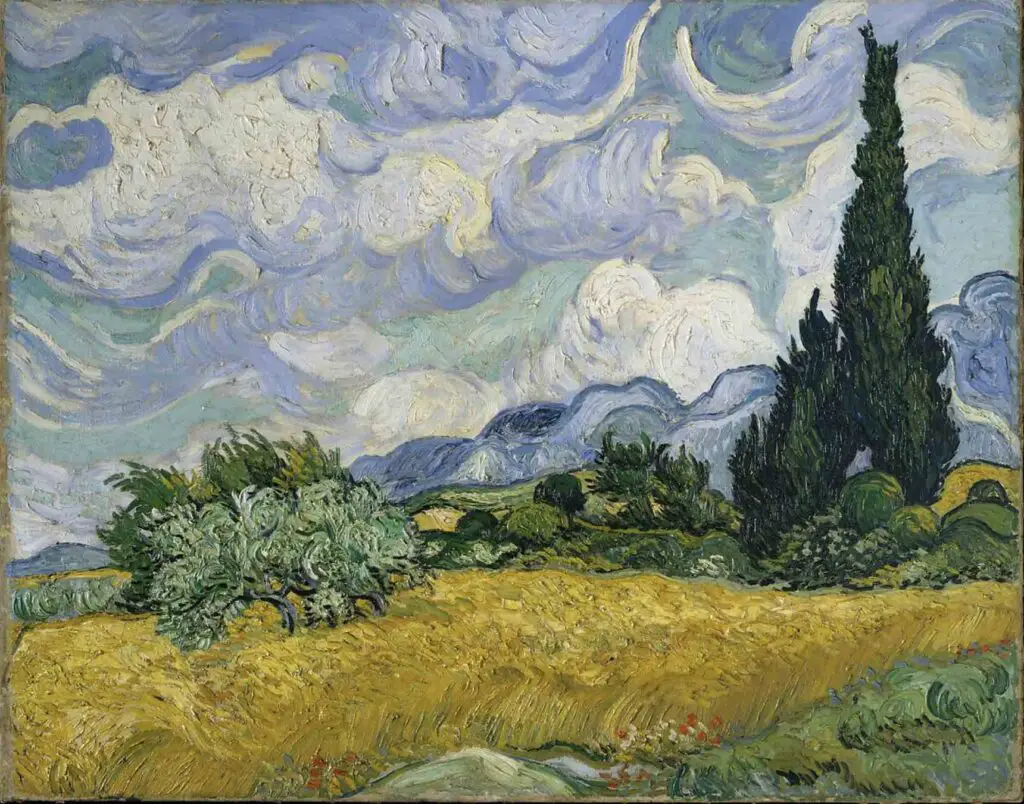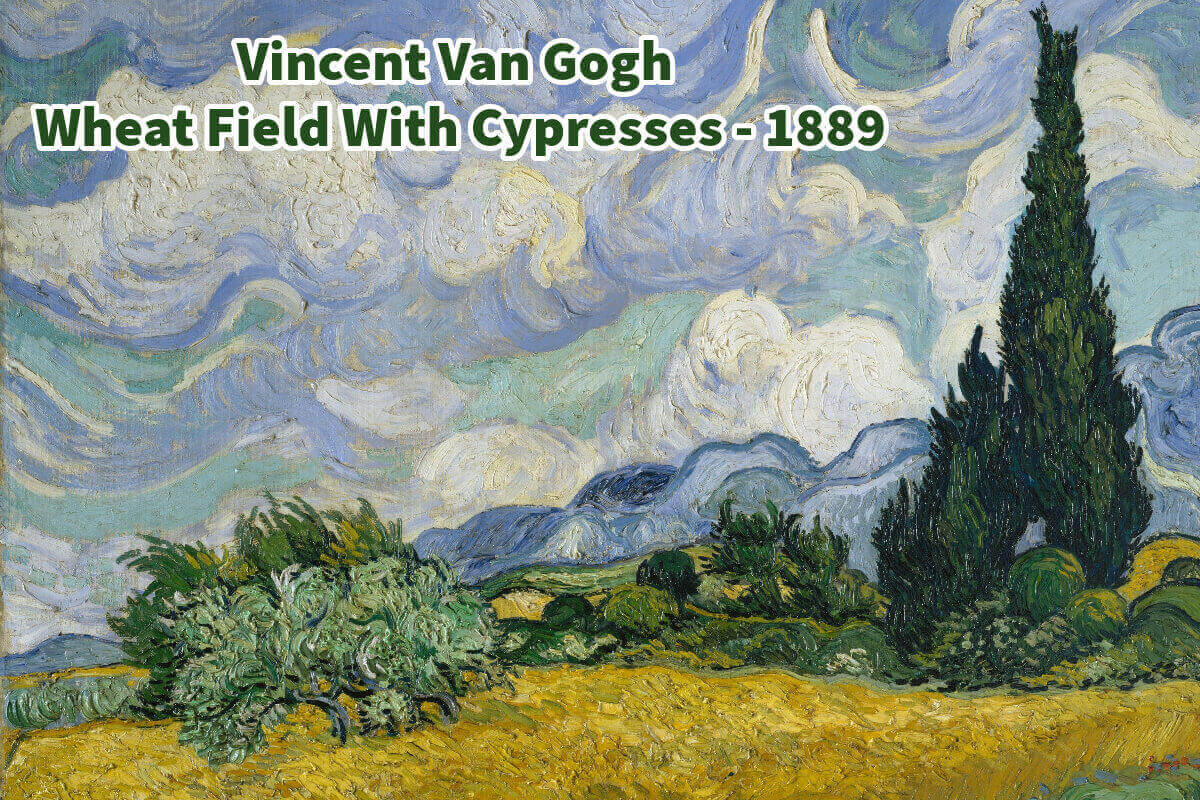Vincent van Gogh, undeniably one of the most esteemed painters in history, left an enduring legacy through his iconic works of art.
Among the subjects he cherished painting, cypress trees held a special place. One such masterpiece is “Wheatfield with Cypresses.” During this period of his artistic journey, Van Gogh’s fascination with these trees was palpable. As we delve deeper into the realm of cypress trees and Van Gogh’s paintings, we uncover a captivating narrative that adds to the rich tapestry of his artistic exploration.
Table of Contents
- Vincent Van Gogh – “Wheat Field With Cypresses” (1889): A Deeper Look
- The Significance Of Cypresses In Van Gogh’s Art
- The Importance Of “Wheat Field with Cypresses” By Vincent Van Gogh
- Exploring Van Gogh’s Other Cypress Paintings
- Frequently Asked Questions
- Related Questions
Vincent Van Gogh – “Wheat Field With Cypresses” (1889): A Deeper Look
Vincent van Gogh, a name synonymous with the Post-Impressionist movement and revered for his emotionally charged works, embarked on a profound artistic journey culminating in some of the most iconic paintings in art history.

Among these masterpieces is “Wheat Field with Cypresses,” painted in 1889 during his stay at the Saint-Paul-de-Mausole asylum in Saint-Rémy-de-Provence. This painting is a testament to Van Gogh’s remarkable talent and a window into his complex psyche.
The Significance Of Cypresses In Van Gogh’s Art
Cypresses gained prominence in Van Gogh’s work in late June 1889, marking a pivotal moment in his artistic exploration. He dedicated a series of paintings to these towering trees during this period. “Wheat Field with Cypresses” is often regarded as one of the standout pieces from this series, and Van Gogh held it in high regard.
The Allure Of Cypresses
Van Gogh’s fascination with cypresses can be attributed to several factors:
1. Symbolism:
Cypresses held deep symbolic meaning for Van Gogh. They were not merely trees but carriers of emotions and metaphors. In many of his letters to his brother Theo, Van Gogh spoke of cypresses representing a sense of longing, despair, and even spirituality. They stood tall and unwavering, much like his resilience in personal struggles.
2. Emotional Expression:
Van Gogh was a master at translating his turbulent emotions onto the canvas. The swirling, almost hypnotic patterns of the cypress branches in “Wheat Field with Cypresses” convey the restlessness that often consumed him. These trees became a means through which he could express his inner turmoil and intensity.
3. A Connection To Nature:
With their distinctive appearance and towering height, Cypresses appealed to Van Gogh’s appreciation for the beauty of nature. He saw them as majestic pillars of the natural world, providing a counterbalance to the flat landscapes of Provence.
The Importance Of “Wheat Field with Cypresses” By Vincent Van Gogh
“Wheat Field with Cypresses” is undoubtedly one of Van Gogh’s standout works, capturing the essence of his unique artistic style and emotional depth. In his own words, he considered it one of his “best” summer landscapes. The painting encapsulates his fascination with cypresses, making them a central element in the composition.
The vibrant yellow wheat field beneath the tumultuous cypress trees creates a stark yet harmonious contrast, representing the interplay between the living earth and the soaring spirit.
Studio Renditions:
In September of the same year, Van Gogh felt compelled to create two studio renditions of this masterpiece. One was a reproduction on the same scale, emphasizing its significance in his artistic oeuvre.
The other, more miniature replica, was a heartfelt gift for his mother and sister. These additional renditions highlight the painting’s enduring impact on the artist himself.
Exploring Van Gogh’s Other Cypress Paintings
While “Wheat Field with Cypresses” stands out prominently, Van Gogh’s fascination with cypresses led him to create several notable works featuring these iconic trees. Let’s examine a few of them and understand why they are essential to the artist’s work.
1. “Cypresses And Two Women” (1890):
This painting, created during Van Gogh’s time at the asylum in Saint-Rémy, features two women walking along a path bordered by cypress trees. It offers a serene and contemplative perspective, emphasizing the harmony between human presence and the natural world.

While still dominant, the cypresses serve as a backdrop to the peaceful scene, suggesting a sense of tranquility and connection.
2. “Cypresses At Saint-Rémy” (1889):
This work is another example of Van Gogh’s deep attachment to cypresses at Saint-Rémy. The cypresses here are depicted more stylized and abstractly, almost resembling flames rising towards the sky.

This abstraction reflects the artist’s desire to convey the emotional intensity he associated with these trees.
3. “Road With Cypress And Star” (1890):
Van Gogh combines the cypress motif with a nighttime landscape in this painting.

The tall, dark cypress tree stands against a starry sky, creating a powerful contrast between the earthy, grounding presence of the tree and the cosmic, almost spiritual, backdrop. This piece encapsulates Van Gogh’s belief in the transcendent power of nature.
Vincent Van Gogh’s affinity for cypress trees during his time in Saint-Rémy-de-Provence represents a profound chapter in his artistic journey. These trees served as more than just subjects for his paintings; they became symbols of his innermost thoughts and emotions. “Wheat Field with Cypresses” is a testament to his genius, capturing the turbulent beauty of his mind and the world around him.
The importance of cypresses in Van Gogh’s art extends beyond this iconic painting, as evidenced by the series and individual works that followed. Each piece offers a unique perspective on his evolving relationship with these trees and their significance in his art.
Van Gogh’s ability to infuse nature with emotion and transform trees into vessels of feeling remains a profound and enduring legacy in the art world. Through his cypress paintings, he invites us to explore the physical world and the depths of the human spirit.
Anita Louise Art is dedicated to art education, great artists, and inspiring others to find and create their art. We love art that uplifts and inspires. #ArtToMakeYouSmile! #ArtToMakeYouHappy!
If you want to see any of my art, you can find out more by clicking here. If you are interested in what inspires me and my paintings, you can discover more by clicking here.
We have a free newsletter and would love you to be part of our community; you can subscribe to the newsletter by clicking here. If you have any questions, I would be happy to talk to you anytime. You can reach me, Anita, by clicking here.
Subscribe to our Anita Louise Art YouTube Channel with great videos and information by clicking here.
Join us for our podcast “5 Minutes With Art.” Spend just 5 minutes a week with us to discover and learn about great art and artists. You can find out more about our podcast by clicking here.
Frequently Asked Questions
What inspired Vincent Van Gogh to paint “Wheatfield with Cypresses” in 1889?
Explore the influences and motivations behind Van Gogh’s decision to create this particular masterpiece and the significance of cypress trees in his work.
How did Van Gogh’s emotional state influence the creation of “Wheatfield with Cypresses”?
Delve into the connection between Van Gogh’s mental health and the emotions that might have found expression in the vibrant strokes and colors of the painting.
What is the significance of cypress trees in Van Gogh’s body of work?
Uncover the symbolic meaning attached to cypress trees in Van Gogh’s paintings, specifically in “Wheatfield with Cypresses,” and how they contributed to the overall theme of the artwork.
What techniques did Van Gogh employ in “Wheatfield with Cypresses” to convey his artistic vision?
Explore the artistic techniques, brushstrokes, and color palette employed by Van Gogh to bring the wheat field and cypresses to life in this particular painting.
What is the connection between nature and Van Gogh’s perception in “Wheatfield with Cypresses”?
Examine how Van Gogh captured the essence of nature in this artwork and how his unique perspective transformed a simple landscape into a profound artistic statement.
Were there any specific locations that inspired the setting of “Wheatfield with Cypresses”?
Investigate whether Van Gogh painted this masterpiece based on a real location and if there are identifiable landscapes that influenced the composition.
How did critics and the public initially receive “Wheatfield with Cypresses” when it was first unveiled?
Explore the contemporary reactions to the painting, considering both critics’ reviews and the public’s reception, shedding light on the initial impact of this masterpiece.
What role did Van Gogh’s personal life play in shaping “Wheatfield with Cypresses”?
Uncover any personal experiences, events, or emotions from Van Gogh’s life that may have influenced the creation and thematic elements of this particular artwork.
How does “Wheatfield with Cypresses” fit into Van Gogh’s broader artistic evolution?
Place this painting within the context of Van Gogh’s artistic journey, considering how it reflects his evolving style, themes, and techniques during the late 1880s.
Are there any hidden symbols or details in “Wheatfield with Cypresses” that require a closer look to be appreciated?
Encourage a detailed examination of the painting, discussing any subtle symbols, details, or hidden elements that might add layers of meaning to “Wheatfield with Cypresses.”
Related Questions
The Art Of Living: 40 Inspirational Quotes By Vincent Van Gogh
Vincent Van Gogh, one of the most celebrated and influential artists of all time, was not only known for his captivating and emotionally charged paintings but also for his inspirational quotes that offer timeless wisdom and guidance. Van Gogh’s words have inspired millions worldwide, from his struggles to his artistic philosophies.
By clicking here, you can learn more by reading The Art Of Living: 40 Inspirational Quotes By Vincent Van Gogh.
Unearthing The Meaning: Potato Eaters By Van Gogh
Vincent van Gogh’s “The Potato Eaters” is a masterpiece that captures the harsh reality of rural life in the Netherlands during the 19th century. The painting features five peasants gathered around a small table, their faces and hands rough and weathered from years of hard work. Van Gogh chose a challenging composition deliberately to prove he was on his way to becoming a good figure painter.
By clicking here, you can discover more by reading Unearthing The Meaning: Potato Eaters By Van Gogh.
Van Gogh’s Sunflower Paintings: A Celebration Of Gratitude
The Sunflower series of paintings by Vincent van Gogh undoubtedly stand as some of his most renowned and cherished works of art. Painted in the scenic town of Arles in southern France between 1888 and 1889, these vibrant masterpieces have enthralled art enthusiasts across the globe. Van Gogh’s creative exploration of a singular color palette featuring captivating variations of yellow demonstrates his artistic prowess. It reveals his eloquence and ability to convey profound emotions through his brushstrokes.
By clicking here, you can discover more by reading Van Gogh’s Sunflower Paintings: A Celebration Of Gratitude.


